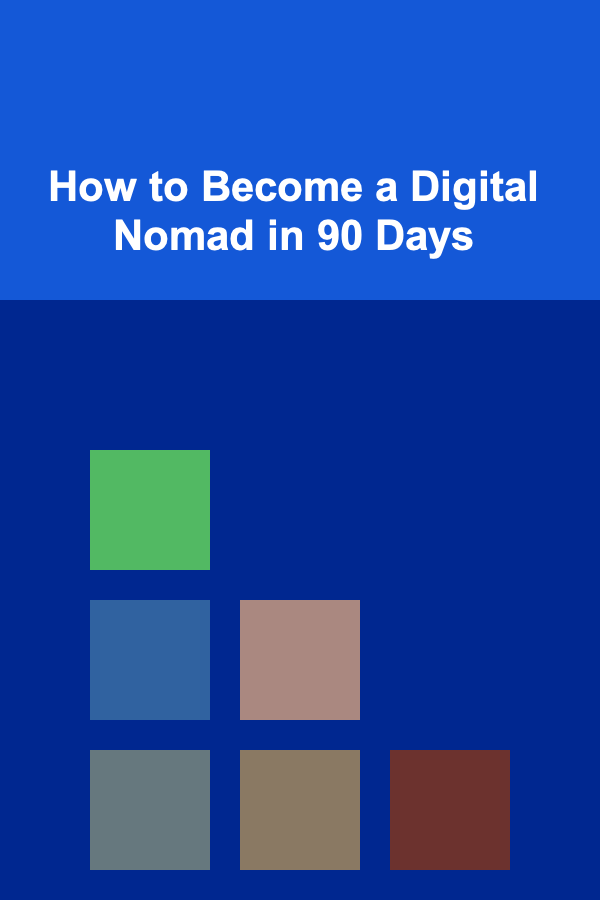
How to Become a Digital Nomad in 90 Days
ebook include PDF & Audio bundle (Micro Guide)
$12.99$8.99
Limited Time Offer! Order within the next:

In today's rapidly evolving world, the idea of becoming a digital nomad has transitioned from a mere dream to an attainable reality for many. Whether you envision yourself working from a beach in Bali, a cafe in Lisbon, or a co-working space in Chiang Mai, the freedom of working while traveling has become a desirable lifestyle. However, embarking on this journey requires more than just buying a plane ticket and setting off; it demands careful planning, strategic execution, and an entrepreneurial mindset.
In this article, we will outline a detailed, step-by-step roadmap to transition into the digital nomad lifestyle in just 90 days. By the end of this guide, you'll have the practical knowledge to become a successful digital nomad who works remotely while traveling the world.
Day 1-30: Laying the Foundation
The first 30 days are dedicated to planning and setting the groundwork for your transition to the digital nomad lifestyle. These initial steps are critical to ensuring that you can work remotely effectively, manage your finances, and have the mindset necessary to succeed on this journey.
1. Identify Your Skills and Find Remote Work Opportunities
The most crucial step to becoming a digital nomad is determining how you will make money remotely. This could mean leveraging your existing skills or developing new ones. Common skills that lend themselves to remote work include:
- Freelancing (writing, graphic design, web development, etc.)
- Virtual assistance
- Online teaching and tutoring
- Marketing and social media management
- Programming and software development
- Consulting or coaching
To get started, identify your core skills and marketable talents. Then, start exploring platforms where you can find remote work opportunities:
- Upwork
- Freelancer
- Fiverr
- Toptal
- We Work Remotely
- Remote OK
- AngelList (for startup jobs)
Take the time to explore these platforms, build a professional profile, and start applying for jobs. If you're currently employed, consider transitioning your job to a remote one or negotiating with your employer to allow you to work remotely.
2. Create a Remote-Friendly Work Setup
A major part of becoming a successful digital nomad is ensuring that your work setup is optimized for productivity. Here are a few things to consider:
- Reliable Technology: Make sure you have a laptop that can handle your work demands, whether it's for design, coding, writing, or other tasks. Invest in accessories like noise-canceling headphones, an ergonomic mouse and keyboard, and a high-quality camera for video calls.
- Internet Connectivity: A strong, reliable internet connection is a must for any digital nomad. While traveling, you'll encounter various types of connectivity, so it's important to research destinations with robust Wi-Fi infrastructure. Also, consider portable Wi-Fi devices or SIM cards with international data plans for when you're on the move.
- Software Tools : Utilize tools that can help you stay productive and communicate effectively while remote. Project management tools like Trello , Asana , or Monday.com help keep track of your tasks. Communication tools like Slack , Zoom , or Google Meet are essential for connecting with clients or team members.
3. Get Your Finances in Order
Being a digital nomad requires a flexible, manageable financial setup. Here are the key areas to address in the first 30 days:
- Create a Budget: Digital nomads often face fluctuating incomes and variable costs of living in different countries. It's important to create a realistic budget that accounts for travel, accommodation, food, and any necessary subscriptions or software tools.
- Set Up Remote Banking : Opening a bank account or using a financial app that supports international transactions can help streamline your finances. Apps like Revolut , Wise (formerly TransferWise) , or N26 are great choices for global banking with low fees.
- Create a Safety Net: Make sure you have enough savings set aside to support yourself during the transition period. Having 3 to 6 months of living expenses in an emergency fund is ideal.
4. Prepare for Travel
Start researching potential destinations that align with your work needs and lifestyle preferences. Consider the following factors:
- Cost of Living: Choose places where your income will stretch further. Cities like Chiang Mai (Thailand), Bali (Indonesia), and Medellín (Colombia) are popular among digital nomads due to their affordable living costs.
- Visas and Legal Requirements: Research visa policies for the countries you're considering. Many digital nomads opt for countries with digital nomad visas, such as Estonia, Barbados, and Portugal.
- Time Zones: If your work requires you to coordinate with clients or teams in different time zones, choose destinations that allow for overlap during working hours.
- Safety and Health: Consider the health infrastructure and safety of potential destinations, especially in light of COVID-19 or other global health concerns.
Day 31-60: Building Your Digital Nomad Network
Once you've laid the foundation, the next step is to start connecting with other digital nomads, building relationships, and expanding your network. This phase also includes refining your work-life balance as you begin to test your remote working routine.
5. Join Digital Nomad Communities
Networking is an essential part of the digital nomad lifestyle. There are many communities, both online and offline, where you can connect with fellow nomads and learn from their experiences. Some of the best places to connect include:
- Facebook Groups: Search for groups like "Digital Nomads" or "Remote Workers" to find communities with other like-minded individuals.
- Meetup.com: Look for meetups in your destination cities, where you can attend events, socialize, and network.
- Nomad List: This website offers valuable insights on digital nomad destinations, cost of living, internet speed, and more. You can also engage with fellow nomads in their forum.
- Coworking Spaces : When you arrive at your destination, look for coworking spaces. These places offer great opportunities for networking and collaboration. Some popular coworking spaces include WeWork , Spaces, and local, independent coworking venues.
6. Test Your Productivity and Establish Routines
At this point, you should start testing your work routines. Establishing a productive routine is crucial for long-term success. Here's what to focus on:
- Work Hours: Set clear boundaries between work time and personal time. If you work with clients in different time zones, adjust your hours to ensure you're available when needed.
- Create a Morning Routine: Begin your day with rituals that help you stay focused and energized. Whether it's yoga, meditation, or a healthy breakfast, a morning routine can set the tone for a productive day.
- Time Management : Tools like Pomodoro (working in focused sprints) or using time-blocking techniques can help you remain productive during the day.
7. Start Exploring New Destinations
Now that you've begun to settle into the rhythm of remote work, it's time to explore new destinations and broaden your travel experience. Use this phase to gain confidence in your ability to live and work in different environments. Also, be sure to:
- Explore Local Culture: Immerse yourself in the local culture, traditions, and activities to enhance your experience as a digital nomad.
- Try Different Workspaces: Every digital nomad has their preferred working environment. Try working from various settings, whether it's a local cafe, a coworking space, or a library.
Day 61-90: Refining Your Digital Nomad Lifestyle
The final stretch involves refining your digital nomad journey and solidifying the habits, systems, and strategies that will support your long-term success.
8. Scale Your Remote Income
As you become more comfortable working remotely, focus on scaling your income. This could involve:
- Diversifying Your Income Streams: Consider launching an online course, writing an eBook, or monetizing a blog. Multiple streams of income will help provide financial stability while you travel.
- Raising Your Rates: If you're freelancing, consider raising your rates as you gain more experience and build your reputation.
- Passive Income: Look into passive income opportunities, such as affiliate marketing or investing in online businesses, which can free up more of your time.
9. Stay Healthy and Manage Well-Being
Maintaining physical and mental health while on the move is essential to thriving as a digital nomad. Focus on:
- Exercise and Diet: Traveling can disrupt regular exercise, so it's important to find ways to stay active. Look for gyms, yoga studios, or outdoor activities that allow you to stay fit.
- Mental Health: Being on the move constantly can sometimes feel isolating. Stay connected with friends and family, and take time for self-care when necessary.
- Work-Life Balance: As you work and travel, make sure you take time off to enjoy your surroundings. Striking a healthy balance between work and exploration is key to a fulfilling nomadic lifestyle.
10. Evaluate Your Progress and Adapt
By the end of the 90 days, take time to evaluate your journey. Reflect on the challenges you faced, the lessons learned, and what you would do differently in the future.
As a digital nomad, you'll need to be adaptable and open to change. Constantly evaluate your goals, update your work routine, and experiment with new locations to refine your approach.
Conclusion
Becoming a digital nomad in 90 days may seem like an ambitious goal, but with the right approach, it is entirely achievable. By focusing on building your remote career, establishing a flexible routine, and embracing new destinations, you can create a sustainable and fulfilling digital nomad lifestyle.
Remember that the journey doesn't stop after 90 days; it's a continuous process of growth, adaptation, and exploration. The freedom to work from anywhere in the world is within your reach -- all it takes is planning, dedication, and a willingness to take that first step toward your new life.

How to Handle Beneficiary Designations During Benefits Enrollment
Read More
How to Organize Your Kitchen with Creative Storage Ideas
Read More
How to Set Up a Pet-Friendly Backyard with Fencing
Read More
How to Train Yourself to Maintain File Organization Habits
Read More
How to Understand the Adaptations of Intertidal Organisms
Read More
Understanding the Ancient Persian Empire: A Deep Dive
Read MoreOther Products

How to Handle Beneficiary Designations During Benefits Enrollment
Read More
How to Organize Your Kitchen with Creative Storage Ideas
Read More
How to Set Up a Pet-Friendly Backyard with Fencing
Read More
How to Train Yourself to Maintain File Organization Habits
Read More
How to Understand the Adaptations of Intertidal Organisms
Read More